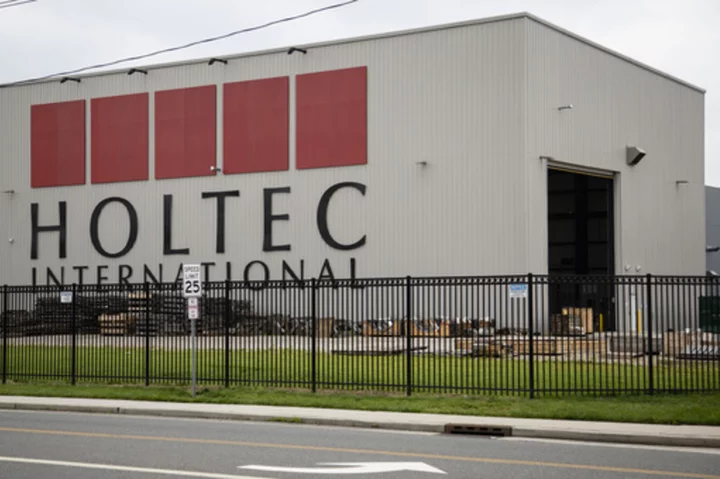ALBUQUERQUE, N.M. (AP) — U.S. nuclear regulators licensed a multibillion-dollar complex to temporarily store tons of spent nuclear fuel in New Mexico from commercial power plants around the nation, a decision likely to be challenged in court.
The Nuclear Regulatory Commission issued its decision Tuesday, saying it will allow the energy company Holtec International to build and operate the facility in southeastern New Mexico. New Jersey-based Holtec may still need to acquire permits from the state, and top New Mexico officials have vowed to fight the project.
Hot and highly radioactive, spent fuel consists of uranium pellets inside metal rods. It can only be handled by machines and people have to be physically shielded from it, usually by steel or concrete.
The New Mexico project would have capacity to temporarily store up to 8,680 metric tons of used uranium fuel. Future expansion could make room for as many as 10,000 canisters over six decades. The material would be transported to New Mexico via rail.
Critics say most would be brought from East Coast sites, prompting concern after recent railway accidents involving other chemicals and cargo.
Gov. Michelle Lujan Grisham and the state’s congressional delegation say they fear New Mexico will become the nation’s dumping ground for spent nuclear fuel because the federal government has no permanent solution for the waste piling up at commercial reactors around the country.
New Mexico approved legislation in March aimed at stopping the project.
“Today’s actions by the NRC illustrate the importance of New Mexico’s new prohibition on the storage and disposal of high-level nuclear waste. It's time that our voice be heard and honored, and that this project be shut down,” said state Sen. Jeff Steinborn, a Democrat who sponsored the measure.
Holtec has argued that the New Mexico measure is pre-empted by federal law and that a court fight would only delay the economic boon that would come from building the complex. The company has spent an estimated $80 million pursuing the 40-year license to build and operate the facility.
“This milestone is the culmination of an eight-year process to bring a safe, secure, temporary and retrievable private facility to help the nation’s spent fuel storage dilemma," Holtec said in a statement thanking regulators.
Company officials and some elected leaders from southeastern New Mexico have been pushing hard to offer what they call a temporary solution to the nation’s problem of spent nuclear fuel. Commercial nuclear reactors across the country produce more than 2,000 metric tons of spent fuel each year, according to the U.S. Department of Energy, with most of it remaining at the sites that produce it because there’s nowhere else to put it. Commercial reactors have generated about 90,000 metric tons of spent fuel since the 1950s. If all of it were stacked together, the agency said the material could fit on a single football field at a depth of less than 10 yards (9 meters).
Since the federal government has failed to build a permanent repository, it reimburses utilities to house the fuel in either steel-lined concrete pools of water or in steel and concrete containers known as casks at sites in nearly three dozen states. The cost of that practice is expected to stretch into the tens of billions of dollars over the next decade.
Kevin Kamps, a radioactive waste specialist with the watchdog group Beyond Nuclear, said transporting highly radioactive waste is inherently high risk and that the casks would be among the heaviest loads on roads, rails and waterways.
“They would test the structural integrity of badly degraded rails, for example, risking derailments,” he said.
Holtec officials have disputed those claims, saying testing has shown the casks used to hold spent fuel would not release radiation even in the event of a derailment.
President Joe Biden has received dueling letters from project supporters and from Lujan Grisham as well as others who oppose it. The administration has acknowledged the role nuclear power will have to play in reaching its carbon emission goals, and earlier this year put up $26 million in grants for communities interested in studying potential of hosting interim storage sites.
Similar battles over what to do with the spent fuel have been waged in Nevada, Utah and Texas over the decades as the U.S. has struggled to find a home for the material and other radioactive waste. The proposed Yucca Mountain project in Nevada was mothballed and a temporary storage site planned on a Native American reservation in Utah was sidelined despite being licensed by the NRC in 2006.
Elected leaders in Texas were unsuccessful in keeping the NRC from licensing a similar project in 2021. The site at the center of that fight is near the Texas-New Mexico border, where Integrated Storage Partners LLC plans to store up to 5,000 metric tons (5,512 tons) of spent fuel and about 230 metric tons of low-level radioactive waste for 40 years. Future phases could boost that capacity to 40,000 metric tons of fuel.

